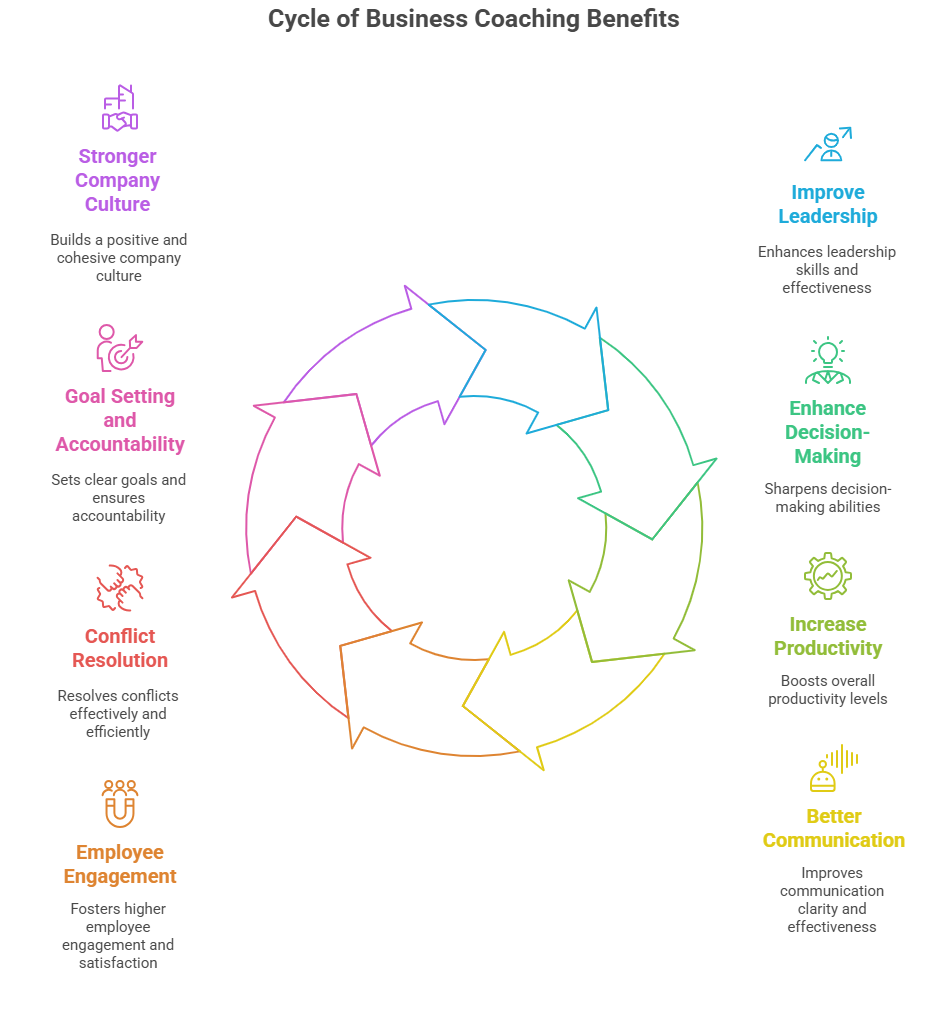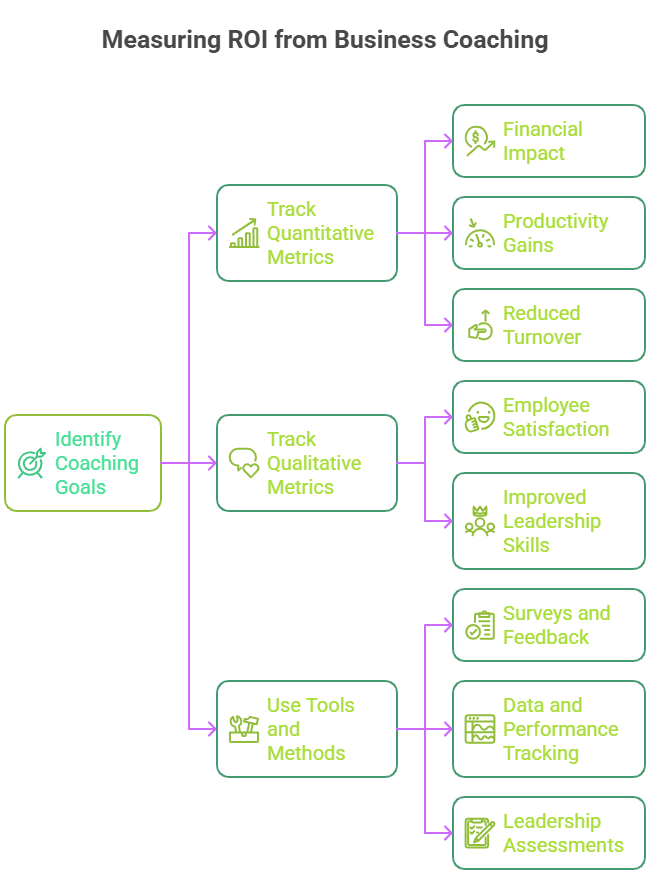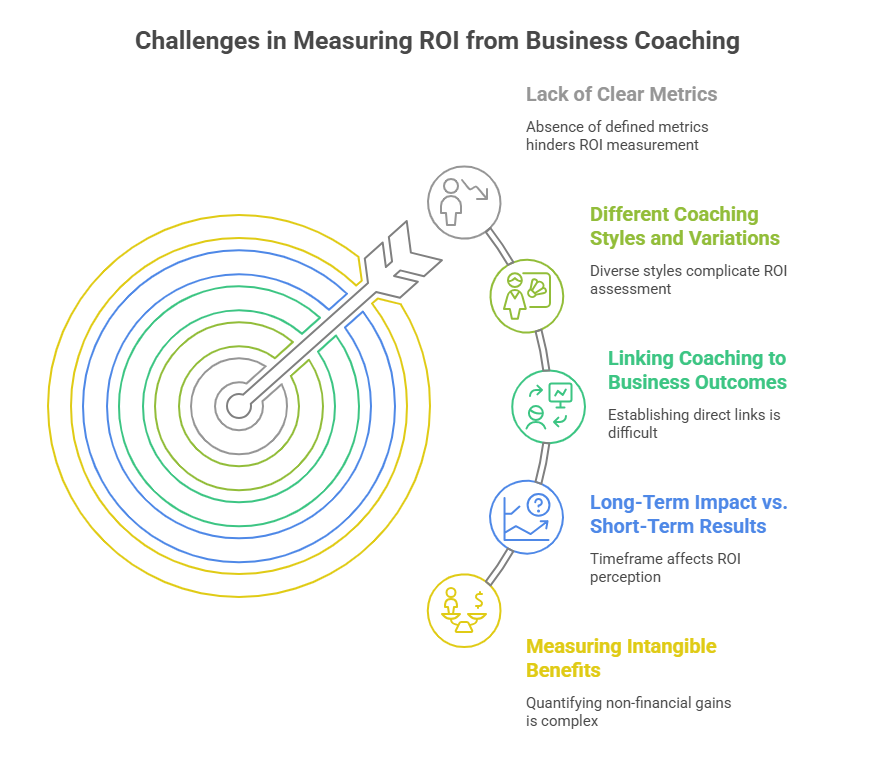Business coaching has become an essential tool for companies looking to boost performance, improve leadership, and tackle challenges more effectively. But how do you measure the success of these coaching efforts? Simply put, the Return on Investment (ROI) of business coaching shows you whether the time and money spent on coaching are paying off.
Imagine this: A business invests in coaching for its leadership team. A few months later, they see better decision-making, more motivated employees, and improved efficiency. Sounds great, right? But how do you prove that these improvements are truly the result of the coaching?
Measuring ROI from business coaching goes beyond just numbers. While financial metrics like revenue growth or cost savings are easy to track, there’s also the less tangible side: higher employee engagement, stronger leadership skills, and improved morale. So, how do you bring all these elements together and determine what the coaching actually contributed?
In this guide, we’ll explore the key metrics you can use to measure ROI from business coaching, share real-world examples, and address common challenges in evaluating success.
Let me show you how to assess whether your business coaching efforts are truly worth it.
Understanding Business Coaching and Its Benefits
Business coaching is a collaborative process that helps individuals and organizations achieve their goals by focusing on personal and professional growth. It’s more than just advice or training; it’s about guiding leaders, teams, and businesses through challenges, fostering development, and improving performance. Business coaching often involves working one-on-one with executives, managers, or entire teams to build key skills, improve communication, and enhance decision-making. It’s designed to empower individuals with the tools they need to succeed and drive the organization forward.

Here are some of the key benefits of business coaching:
- Improved Leadership: Coaching helps leaders sharpen their skills, making them more effective in guiding their teams and making strategic decisions.
- Enhanced Decision-Making: With the right guidance, leaders can approach challenges with a clearer mindset, leading to better decisions that impact the company’s growth.
- Increased Productivity: Coaching enables individuals to focus on their strengths, streamline their processes and ultimately boost productivity.
- Better Communication: Coaches help improve communication skills, ensuring that messages are conveyed clearly and effectively, leading to fewer misunderstandings within teams.
- Employee Engagement: Business coaching fosters an environment of personal growth, which can lead to more motivated and engaged employees.
- Conflict Resolution: Coaches provide tools to handle conflicts efficiently, reducing tensions and promoting a healthier workplace environment.
- Goal Setting and Accountability: Coaching helps set clear, actionable goals and holds individuals accountable, which can increase both individual and team performance.
- Stronger Company Culture: By focusing on leadership development, business coaching can strengthen company values, fostering a positive and supportive work culture.
These benefits combine to create lasting change, helping organizations become more efficient, resilient, and successful in achieving their goals.
ROI: What It Means in the Context of Business Coaching

When we talk about ROI (Return on Investment) in business coaching, it’s not just about numbers on a balance sheet. While financial gains like revenue growth or cost reduction are often the first things that come to mind, business coaching can offer more than just a direct financial return. Think of it like planting a tree you might not see the full growth overnight, but over time, it can yield long-term benefits that are just as valuable.
In the context of business coaching, ROI means measuring the impact the coaching has had on both the individual and the organization. It’s about looking at how coaching contributes to improving performance, decision-making, employee engagement and leadership whether or not that leads directly to higher profits.
So, how do you know if business coaching is paying off?
- Is your team more engaged and motivated?
- Have leaders become more effective in making decisions?
- Are employees more productive and satisfied with their work?
These are all signs of positive ROI. Measuring ROI from business coaching goes beyond just tracking revenue it’s about assessing whether the coaching is driving meaningful change in the way people work, interact and lead.
How to Measure ROI from Business Coaching

Measuring ROI from business coaching is about more than just looking at a dollar amount it’s about seeing how coaching impacts the day-to-day operations, performance, and culture of your organization. The value can come in many forms, not just financial. So, how do you measure it?
Think of it like a fitness routine. While you may not see immediate results, over time, you notice your strength improving, your energy levels rising, and your overall well-being getting better. Business coaching works in a similar way. It takes time, but the results are there if you know what to look for.
Here’s how you can track ROI:
Quantitative Metrics to Track ROI
- Financial Impact: This is the easiest to track. Look at things like revenue growth, cost savings, or profit margins before and after coaching. These numbers are concrete and can give you a clear idea of whether the coaching led to increased profitability.
- Productivity Gains: Has work output increased? Maybe employees are completing tasks faster or meeting more of their goals. Tracking improvements in efficiency or task completion rates can show the direct impact coaching has had on productivity.
- Reduced Turnover: Coaching can help improve job satisfaction, leading to a more stable workforce. Tracking employee retention rates before and after coaching can show whether coaching has contributed to a more engaged and loyal workforce.
Qualitative Metrics to Track ROI
- Employee Satisfaction: It’s not all about the numbers. Employee morale and engagement are crucial to measuring coaching success. Are employees more motivated? Are they happier with their work? Employee surveys or feedback can give you a sense of how coaching is affecting the company culture.
- Improved Leadership Skills: The strength of leadership can make or break a company. If coaching has made your leaders better at decision-making, communication, or managing teams, that’s a solid ROI indicator. You can measure this through feedback from teams or through specific leadership assessments.
Tools and Methods for Measuring ROI
- Surveys and Feedback: One of the easiest ways to measure ROI is by asking. Employee surveys, team feedback, and 360-degree reviews can all provide valuable insights into how coaching has impacted employees’ day-to-day work and the overall company culture.
- Data and Performance Tracking: Use performance tracking software to measure changes in employee productivity and business outcomes. This can help you capture any shifts that happen after coaching and help connect those changes to specific business goals.
- Leadership Assessments: For leadership coaching, tools like leadership assessments or performance reviews can show how much improvement has been made in key leadership skills.
Measuring ROI isn’t always as straightforward as it seems, but with the right metrics and tools, you can get a clear picture of how business coaching is benefiting your organization.
Overcoming Challenges in Measuring ROI from Business Coaching

Measuring the ROI of business coaching can be tricky. It’s not always about simple numbers. Some changes are hard to see right away, and some don’t have an easy way to be measured. But that doesn’t mean it’s impossible. Think of it like trying to measure how much a plant has grown. Some parts of it might be hidden beneath the soil, but with the right tools and patience, you’ll see it grow over time.
Here are some of the most common challenges businesses face when measuring ROI from coaching and how to tackle them:
Measuring Intangible Benefits
Not everything that coaching improves can be counted or directly tied to profits. Things like improved communication, better team morale, and stronger leadership aren’t easily measured by a spreadsheet. So, how do you track these kinds of benefits?
Solution: Use surveys and feedback to gauge employee satisfaction and engagement. You can also track progress through regular performance reviews or 360-degree feedback to see if leadership and team dynamics are improving. These tools give a clearer picture of softer, but valuable, outcomes.
Long-Term Impact vs. Short-Term Results
Some benefits of business coaching take time to fully show up. You might not see immediate financial growth, but that doesn’t mean the coaching didn’t work. It’s like planting seeds you won’t see the flowers right away.
Solution: Track progress over time. Set up benchmarks for both short-term and long-term goals, so you can compare where you are before, during, and after coaching. This way, you’ll get a better sense of how coaching affects long-term performance, even if the results aren’t instant.
Linking Coaching to Business Outcomes
How do you know if an increase in sales or a decrease in employee turnover is because of coaching or other factors? It can be tough to make a direct connection.
Solution: To isolate the impact of coaching, try using control groups or tracking multiple variables over time. For example, compare teams that received coaching with those that didn’t. This will help show the direct effects coaching had on the business.
Different Coaching Styles and Variations
Coaching isn’t a one-size-fits-all solution. Different coaches use different methods, and every individual or team may respond differently. This can make it harder to measure consistent results.
Solution: Standardize how you measure success. Even though coaching styles vary, you can still use consistent metrics to track progress, such as leadership assessments or productivity metrics. Make sure you have clear goals set out from the start, and evaluate whether the coaching met those objectives.
Lack of Clear Metrics
One of the biggest barriers to measuring ROI is not knowing what to measure. Without a clear set of metrics, you’re left guessing about whether the coaching is working.
Solution: Set clear, measurable goals from the start. Whether it’s improving productivity by a certain percentage, enhancing employee satisfaction or increasing leadership effectiveness, having specific targets to aim for makes it easier to measure whether coaching was a success.
Conclusion
Measuring ROI from business coaching isn’t always a straightforward process, but it’s essential for understanding the true value of these investments. From tangible metrics like revenue growth and employee retention to the more intangible benefits like improved leadership and communication, business coaching can have a significant impact on both individuals and the organization as a whole.
By using a mix of quantitative and qualitative metrics, along with the right tools and tracking methods, businesses can get a clearer picture of how coaching contributes to their overall success. While challenges in measuring ROI are inevitable, with careful planning and patience, these challenges can be overcome.
So, the next time you invest in business coaching, take the time to track and measure the results. With the right approach, you’ll not only be able to see the financial returns but also the lasting improvements in leadership, employee engagement and organizational performance. Business coaching can truly make a difference but only if you measure its impact properly.
Now that you know how to track ROI, it’s time to start implementing these strategies and see how your business coaching efforts pay off.





